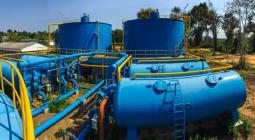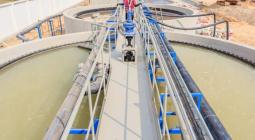AFRICA: what progress has been made in terms of clean water supply in the continent?
The year 2023, which comes to an end in a few days’ time, will have been rich in initiatives in the African water sector. National and international experts are unanimous on this fact. Major projects were completed this year, such as the Binza Ozone drinking water plant in February 2023, with a capacity of 110,000 m3 per day. The plant, located west of Kinshasa in the Democratic Republic of Congo (DRC), supplies 1.5 million households connected to the Régie de distribution d’eau (Regideso) network.
In Ivory Coast, the Mé plant, located in the sub-division of Brofodoumé in the autonomous district of Abidjan, also came into service in 2023 after five years’ work. Thanks to this facility (240,000 m3 per day), more than 2 million additional people living in the north of Ivory Coast’s economic capital now have access to clean water, particularly in Cocody, Abobo and Youpougon, as well as in the east.
In almost all African countries, 2023 was also marked by the launch of a plethora of drinking water projects. In Cameroon, the second phase of the nine-town drinking water supply project (Projet d’alimentation en eau potable de neuf villes – PAEP) began on 28 August 2023 in Garoua-Boulaï, in the Lom-et-Djerem department of the East region, and also covers the towns of Garoua, Maroua, Yabassi and Dschang. It will provide a drinking water production capacity of 74,400 m3 per day over the next 36 months.
In the province of Gaza in southern Mozambique, the government plans to build 74 new boreholes to support existing installations. At least 60,000 more people will be supplied with drinking water over the next seven years thanks to these facilities. In several countries, these projects are determined to achieve MDG6 for the well-being of their populations. We now need to take into account the climatic parameters that determine the nature of any project.
Seawater desalination in support of MDG 6
At the end of 2023, the countries of North Africa are still the most advanced in the development of non-conventional water resources. This is to be expected, as they have had to contend with persistent drought for several years now, with freshwater resources becoming increasingly scarce as a major consequence. So, from Egypt to Algeria, via Morocco and Tunisia, the construction of seawater desalination plants is continuing apace. In Algeria, for example, five seawater desalination plants are currently under construction in Oran, Boumerdès, El Tarf, Bejaïa and Fouka 2. Each facility will have a production capacity of 300,000 m3 of fresh water per day, giving a total capacity of 1.5 million m3 for all the plants by December 2024.
In addition to seawater desalination, the reuse of treated wastewater is also an alternative to drinking water shortages. While this practice has already been popularised to improve access to water for irrigation and watering, to date there has been very little change in attitudes towards the reuse of treated wastewater as drinking water. Namibia remains the only country to rely on this solution to supply its population. On 12 December 2023, the Namibian government announced that it would be rehabilitating the Gammams and Otjomuise wastewater treatment plants in Windhoek to supply drinking water.
Commitments made in 2023 for “water for all” in Africa by 2030?
Finally, will Africa achieve MDG6 by 2030? A number of players in the water sector think not. “There have certainly been a number of water installations inaugurated on the continent, but it’s so insufficient that I feel like saying that we’re behind on the 2030 objectives”, says Malek Semar, founder of the association “No Water No Us”, which raises awareness and takes action for water in Africa and elsewhere.
The latest report (2023) on sustainable development in Africa, published on the sidelines of the 78th United Nations General Assembly held in New York in September 2023, also assesses the continent’s progress in implementing MDG6.The document shows that African countries have improved access to safely managed drinking water services, but that there is still a significant disparity between rural and urban areas. Three out of five Africans, or 411 million people, still lack safe drinking water.
The report entitled “Accelerating recovery from the coronavirus pandemic (Covid-19) and the full implementation of the 2030 Agenda for Sustainable Development and the African Union’s Agenda 2063 at all levels” also calls on African countries to invest in water, sanitation and hygiene infrastructure and to build capacity for integrated water resource management. Out of 48 countries assessed in Africa, only Egypt and Tunisia appear to be on track to achieve the goal of universal basic sanitation by 2030.
To support the other African countries still lagging behind, notably because of insufficient funding, the African Union Commission (AUC) launched a campaign at the 78th United Nations General Assembly, in collaboration with the International High-Level Panel on Water Investments for Africa, to mobilise the necessary funds from development leaders and partners. According to Senegalese President Macky Sall, water funding for Africa currently fluctuates between $10 billion and $19 billion a year, short of the $30 billion a year needed. According to him, “of the 780 million people in the world who live without water, 320 million are in Africa. While this figure masks disparities between countries, it reflects the urgent need to mobilise all available resources to make up for this water deficit, which has a negative impact on health, education, electricity and agriculture”.
In addition to funding, the World Health Organisation (WHO), in its March 2023 report, proposes that solutions be put into action. “We urge governments to take action with the support of United Nations entities, multilateral partners, the private sector and civil society organisations. This means driving change, guiding funding and funding decisions, and investing in people and institutions”. The organisation also suggests facilitating data collection to improve the decision-making process, and encouraging innovation and experimentation in the water, sanitation and hygiene (WASH) sector.
Cover photo: Is Africa a little further ahead in terms of drinking water supply today? AFRIK 21 consulted a number of players in the sector, as well as reports from international organisations, as 2023 draws to a close. While the feedback is encouraging, much remains to be done just six years before 2030, the deadline set by the United Nations for achieving the sixth Sustainable Development Goal (SDG6).





